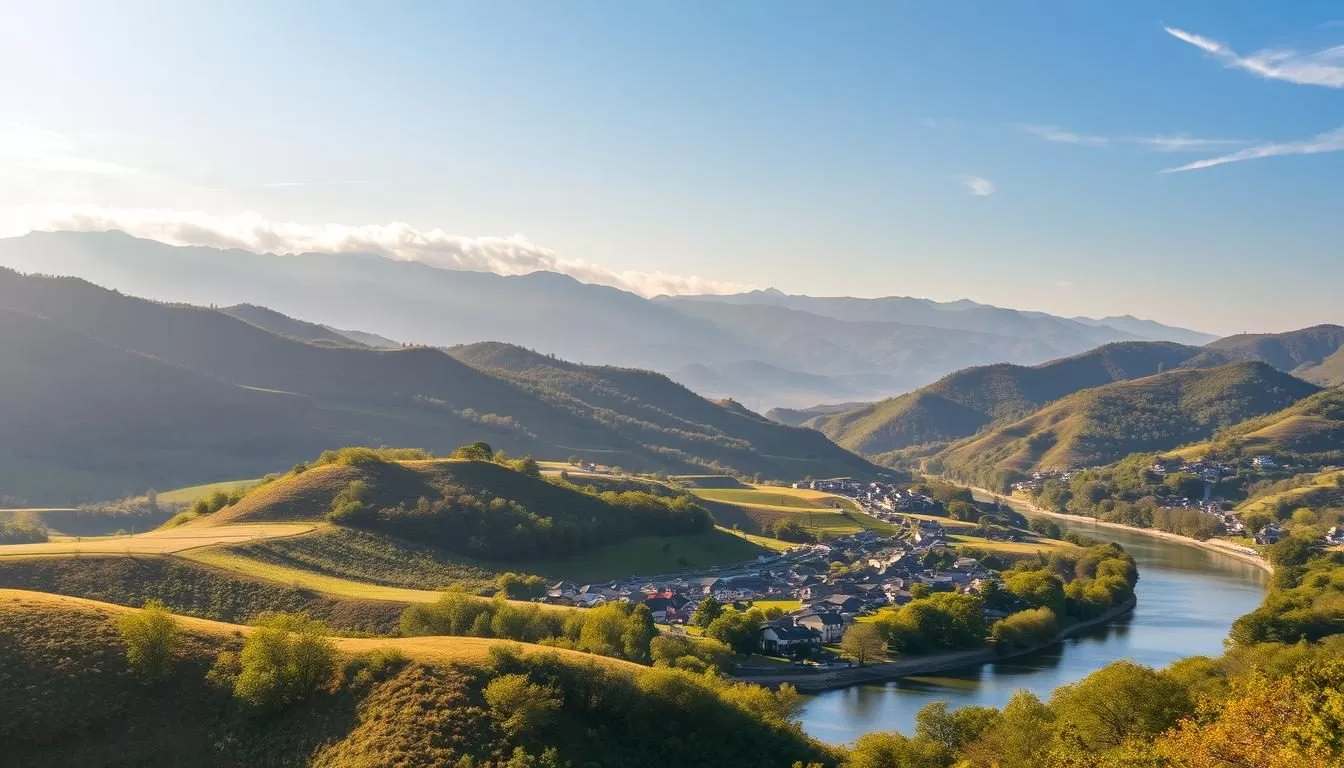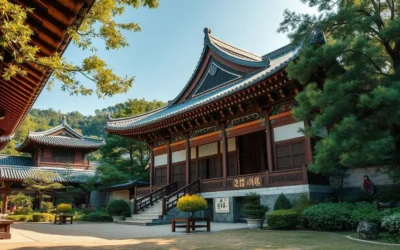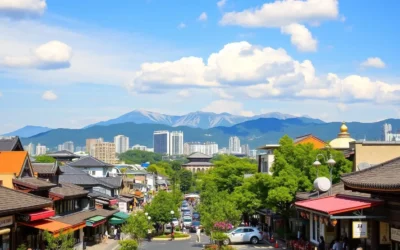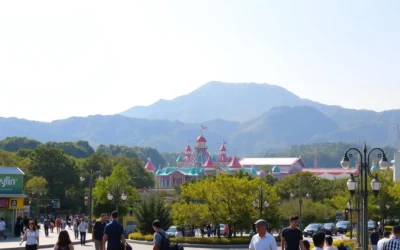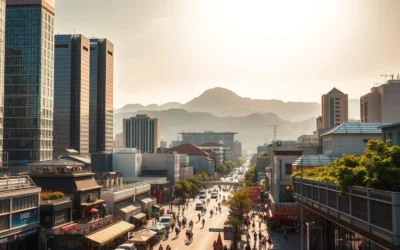✓ Accommodations ✓ Flights ✓ Rental Cars
Planning a trip to South Jeolla Province can be a delightful experience, especially when you time your visit right.
The region offers a unique blend of natural beauty and cultural heritage, making it a must-visit destination in South Korea. To make the most of your trip, understanding the local weather patterns is crucial.
The best time to visit this beautiful southern region is during the spring and autumn months when the weather is mild and pleasant. By choosing the right time for your visit, you can enjoy the region’s top tourist attractions without the extreme temperatures.
Whether you’re looking for outdoor adventures or cultural experiences, South Jeolla Province has something to offer. Let’s explore the ideal months to plan your weather-savvy trip.
Understanding South Jeolla Province’s Climate
With its unique geographical location, South Jeolla Province experiences a wide range of weather conditions across four distinct seasons. Located in the southwestern part of South Korea, the province’s climate is influenced by its proximity to the ocean and its topography.
Geographical Location and Its Impact on Weather
South Jeolla Province’s geographical location plays a significant role in shaping its climate. The province is bordered by mountains to the north and the sea to the south, creating a diverse range of microclimates within the region. This unique geography contributes to the varied weather patterns experienced throughout the year.
Four Distinct Seasons in South Jeolla
The province experiences four distinct seasons, each with its own charm. Spring, which spans from March to May, brings mild temperatures and the famous cherry blossom season. Summer (June to August) is characterized by high temperatures and humidity, with a significant amount of rainfall during the monsoon season. Autumn (September to November) offers pleasant temperatures and spectacular foliage, making it a popular time to visit. Winter (December to February) brings cooler temperatures and occasional snowfall, though less than in the northern regions of South Korea.
| Season | Months | Characteristics |
|---|---|---|
| Spring | March to May | Mild temperatures, blooming flowers, cherry blossoms |
| Summer | June to August | High temperatures, humidity, monsoon rains |
| Autumn | September to November | Pleasant temperatures, clear skies, foliage |
| Winter | December to February | Cooler temperatures, occasional snowfall, winter festivals |
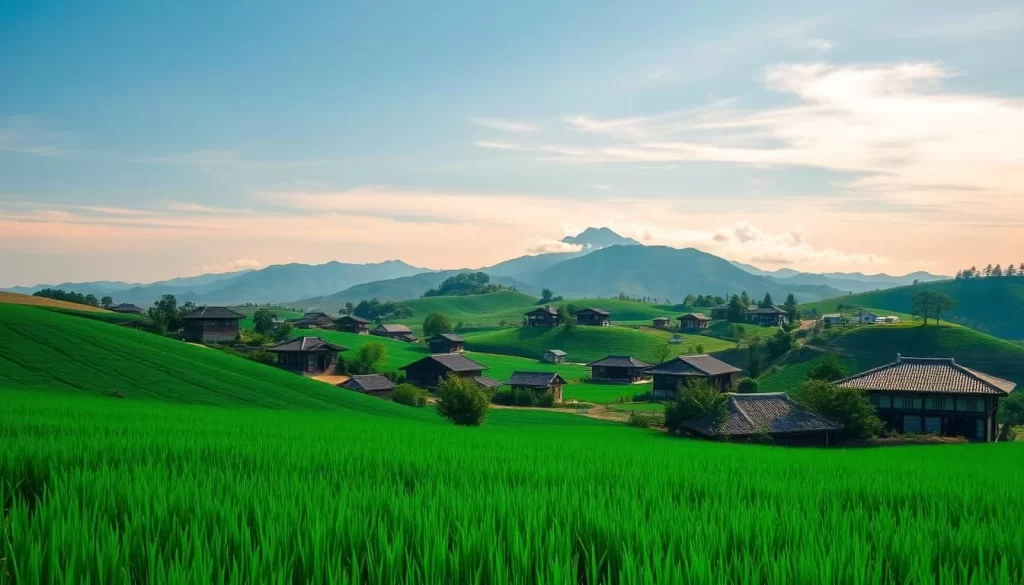
Understanding these seasonal variations is key to planning your trip to South Jeolla Province. Whether you’re looking for the beauty of spring or autumn, or you’re interested in experiencing the unique activities each season has to offer, knowing what to expect can enhance your travel experience. The transitional times of spring and autumn are generally considered the best time to visit, offering comfortable temperatures and natural beauty.
Spring in South Jeolla: Cherry Blossoms and Mild Temperatures
Spring in South Jeolla is a season of renewal, marked by picturesque cherry blossoms and a plethora of cultural festivals. As the province transitions from the cold winter months, the weather becomes increasingly mild, making it an ideal time to visit and experience all that South Jeolla has to offer.
March to May Weather Patterns
During the spring months, March to May, South Jeolla Province experiences a gradual warming trend. Temperatures range from cool to mild, creating perfect conditions for outdoor activities and sightseeing. The average highs during this period range from 18°C to 23°C (64°F to 73°F), making it an ideal time for exploring the region’s natural beauty.
Cherry Blossom Season Highlights
The cherry blossom season is a major highlight of spring in South Jeolla. Yeosu’s Jinnam Cherry Blossom Festival is a must-visit event, offering not only stunning cherry blossoms but also local seafood specialties and traditional performances. The festival is a celebration of spring’s arrival and provides a unique cultural experience for visitors.
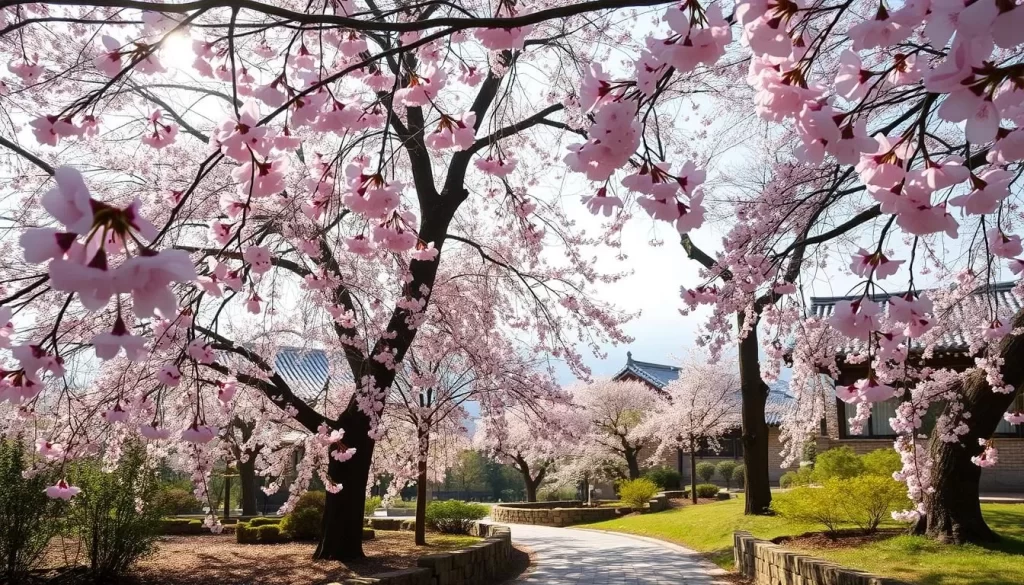
Spring Festivals and Cultural Events
Spring in South Jeolla is filled with various festivals and cultural events. The Boseong Green Tea Festival in early May is a significant event, celebrating the region’s famous green tea plantations with tastings, ceremonies, and cultural performances. Additionally, Buddha’s Birthday celebrations transform the province’s Buddhist temples with colorful lanterns and special ceremonies, offering a unique cultural experience.
| Festival/Event | Location | Time |
|---|---|---|
| Yeosu’s Jinnam Cherry Blossom Festival | Yeosu | Late March to Early April |
| Boseong Green Tea Festival | Boseong | Early May |
| Buddha’s Birthday Celebrations | Various Buddhist Temples | April or May (Lunar Calendar) |
These spring festivals and events provide visitors with a rich cultural experience, allowing them to engage with local traditions and enjoy the region’s natural beauty. If you’re planning to visit South Korea during the spring, South Jeolla Province is a must-visit destination, offering a blend of cultural heritage and natural landscapes.
Summer Considerations: Navigating Heat and Monsoon Season
Summer in South Jeolla Province brings both challenges and unique experiences for travelers. While the heat and humidity can be intense, the region offers a range of activities and events that make it a worthwhile visit.
June to August Temperature and Humidity Levels
During the summer months, South Jeolla Province experiences high temperatures and humidity. Daytime temperatures often soar above 30°C (86°F), with humidity levels making it feel even hotter. It’s essential to pack light, breathable clothing and stay hydrated during your visit.
Monsoon Rains and Typhoon Possibilities
Summer is also the monsoon season in South Korea, with July and August being the wettest months. While the rain can be heavy at times, it often comes in short bursts, followed by sunshine. There’s also a possibility of typhoons, which can impact travel plans. Staying informed about weather forecasts is crucial during this time.
Summer Activities Despite the Heat
Despite the challenging weather conditions, summer in South Jeolla offers unique experiences. You can enjoy the Boryeong Mud Festival in mid-July, which takes place in South Korea. Coastal areas like Yeosu and Wando become popular destinations, offering relief from the heat at their beaches. Early morning and evening hours are ideal for exploring outdoor attractions like Suncheon Bay Ecological Park.
| Activity | Location | Best Time |
|---|---|---|
| Beach Activities | Yeosu, Wando | Early morning or evening |
| Boryeong Mud Festival | Boryeong | Mid-July |
| Visit Suncheon Bay Ecological Park | Suncheon | Early morning or evening |
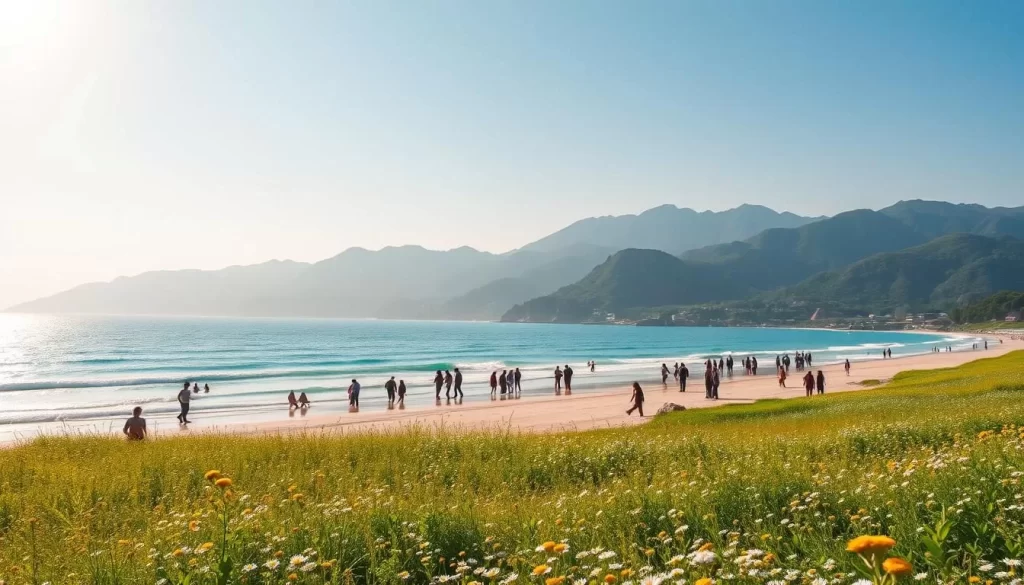
When planning your time visit to South Jeolla during summer, consider these factors to make the most of your trip. With proper preparation, you can enjoy the unique experiences that this season has to offer.
Autumn: The Golden Season for South Jeolla Province, South Korea: Best Months for a Weather-Savvy Trip
With the arrival of Autumn, South Jeolla Province transforms into a picturesque landscape, inviting travelers to explore its natural and cultural treasures. This season is particularly special as it brings a comfortable climate and a plethora of festivals that celebrate the region’s rich agricultural heritage and cultural traditions.
September to November Climate Conditions
From September to November, South Jeolla Province experiences mild temperatures, making it an ideal time to visit. The average temperature ranges from 10°C to 20°C (50°F to 68°F), providing a comfortable environment for outdoor activities and sightseeing. The weather is generally sunny, with a gentle breeze that adds to the pleasant atmosphere.
As the season progresses, the humidity decreases, and the air becomes crisper, making it perfect for enjoying the fall foliage and participating in outdoor festivals.
Fall Foliage and Natural Beauty
Autumn in South Jeolla Province is renowned for its stunning fall foliage. The region’s mountains and valleys are painted with vibrant colors, creating a breathtaking landscape. The golden hues of the reed fields in Suncheon’s Bay and the tea plantations in Boseong are particularly noteworthy.

The natural beauty of the region is further enhanced by the pleasant weather, making it an ideal time for hiking, photography, and other outdoor activities.
Harvest Festivals and Cultural Experiences
Autumn in South Jeolla Province is also a time for harvest festivals, which offer a glimpse into the region’s rich cultural heritage. Chuseok, the Korean Thanksgiving, is one of the most significant festivals, usually falling in September or October. Visitors can experience traditional Korean culture firsthand by participating in or attending these festivals.
Other notable festivals include the Namdo Food Festival, which showcases the region’s culinary delights, and the Suncheon’s Bay Reed Festival, which celebrates the beauty of the golden reed fields. These events provide a unique opportunity to immerse oneself in local culture and enjoy the region’s specialties.
Winter Adventures: Cold but Rewarding
Experience the tranquil winter wonderland of South Jeolla Province, where cold weather meets warm cultural heritage. You can enjoy a serene landscape and participate in unique cultural events during your visit.
December to February Weather Expectations
During the winter months, South Jeolla Province experiences cold temperatures, with average lows ranging from -2°C to 0°C (28°F to 32°F). You should pack warm clothing for your trip. Despite the chill, the clear skies offer breathtaking views of the province’s landscapes.
Winter Activities and Attractions
Winter is an excellent time to explore South Jeolla’s cultural attractions without the crowds. You can visit temples and historical sites, enjoying the serene atmosphere. Some popular activities include:
- Participating in ice fishing and seafood tastings at winter fishing festivals along the coast.
- Experiencing traditional Korean culture at temple rites and Bell Ringing Ceremonies on New Year’s Eve.
Lunar New Year and Winter Festivals
The Lunar New Year, or Seollal, typically falls in January or February and is a significant cultural event in South Korea. You can witness traditional folk games, performances, and food at special Lunar New Year events in traditional folk villages. The Gwangyang Maehwa (Plum Blossom) Festival, marking the earliest spring flowering, is another highlight.
| Event | Date | Description |
|---|---|---|
| Seollal (Lunar New Year) | January or February | Traditional Korean New Year celebrations with temple rites, family feasts, and cultural events. |
| Gwangyang Maehwa Festival | Late February | Celebration of plum blossoms, marking the beginning of spring. |
| Winter Fishing Festivals | Throughout winter | Opportunities for ice fishing and seafood tastings along the coast. |
Practical Travel Tips for Each Season
As you prepare for your journey to South Jeolla, it’s essential to grasp the practical travel tips for each season. Understanding the seasonal variations will help you make the most of your trip.
What to Pack Based on When You Visit
Packing appropriately is crucial for a comfortable trip. In spring and autumn, layers are key due to the mild temperatures. Summer requires light, breathable clothing, while winter demands warm, insulated attire. Don’t forget to check the weather forecast before your trip to ensure you’re prepared for any conditions.
Transportation Considerations by Season
Transportation in South Jeolla can vary by season. During peak travel times, such as cherry blossom season or autumn foliage, public transportation may be more frequent. However, it’s wise to plan ahead and consider renting a car for more flexibility, especially during less busy periods.
Accommodation Availability and Pricing Fluctuations
Accommodation prices can fluctuate significantly with the seasons. During peak seasons, such as summer and autumn, prices tend to be higher. Booking in advance is recommended to secure the best rates. Conversely, visiting during the shoulder season can offer more affordable options.
Avoiding Crowds During Peak Travel Times
To avoid crowds, consider visiting popular sites on weekdays rather than weekends. Early morning visits can also provide a more serene experience. Additionally, exploring lesser-known locations can offer a similar experience to famous spots without the throngs of people. By planning your visit strategically, you can enjoy a more relaxed trip and make the most of your time in South Jeolla Province.
Conclusion: Choosing Your Ideal Time to Visit South Jeolla
The ideal time to visit South Jeolla Province largely depends on your preferences and what you want to experience. Whether you’re drawn to the vibrant cherry blossoms of spring or the serene autumn landscapes, South Jeolla has a season that’s perfect for you.
Spring (March-May) and autumn (September-November) are particularly popular due to their comfortable weather and scenic beauty. Spring offers a visually stunning experience with cherry blossoms and green tea harvests, while autumn provides spectacular foliage and harvest festivals.
Ultimately, your best time to visit South Jeolla depends on your interests, whether they’re in cultural immersion, natural landscapes, or outdoor activities. By aligning your trip with the seasonal highlights, you can have a more fulfilling experience in this beautiful province of South Korea.
The above is subject to change.
Check back often to TRAVEL.COM for the latest travel tips and deals.
